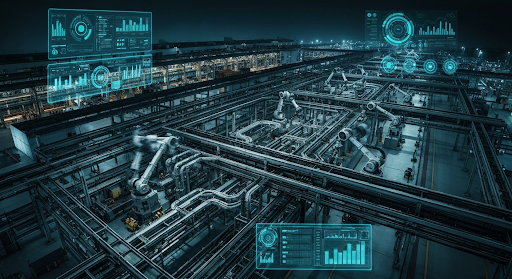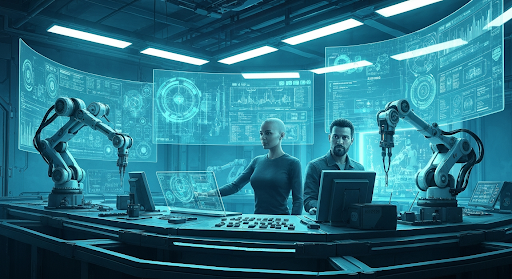What are the four 4 levels of SCADA?
What are the four 4 levels of SCADA?
Supervisory Control and Data Acquisition (SCADA) is a computer-based system used to monitor and control industrial processes from a centralized location. This system allows for remote access to the data, enabling operators to remotely monitor, diagnose and control any industrial process from anywhere in the world. SCADA systems are often used in industries such as oil and gas production, water treatment, manufacturing, power generation and distribution. The control architecture of most industrial automation systems is composed of four hierarchical levels, each with its own set of functions and capabilities. These four levels are the field level, the remote terminal unit (RTU), the Communications level, and the human-machine interface (HMI). The field level consists of various sensors and actuators that are used to measure physical conditions within an industrial process and execute control commands. The RTU is a distributed control system that acts as an intermediary between the communications level and the field-level components. The communications level refers to various communications networks such as Ethernet, Modbus, or other protocols that transmit the various levels of a SCADA system are all interconnected and play a critical role in ensuring that it is able to effectively monitor and control industrial processes. The field level consists of a plethora of sensors, actuators, and other physical components that collect real-time data from the process being monitored. This data is then passed on to the supervisory level, where it can be collected, analyzed, and used to make decisions related to the process. The Remote Terminal Unit (RTU) continuously gathers data from the field devices and transfers it to the supervisory computer for analysis. The Communications module provides a unified platform to connect Programmable Logic Controllers (PLCs) and RTUs. Furthermore, the Human-Machine Interface (HMI) provides workers with a user-friendly graphical interface which allows them to interact with Supervisory Control and Data Acquisition (SCADA) systems. By having a good understanding of the four levels of SCADA systems, companies can ensure that they keep their industrial processes effectively monitored and controlled effectively. This includes ensuring that any changes or modifications that are made to the system are done in a safe and efficient manner, while also ensuring that all data is securely stored and accessible.
Working principle of SCADA system
SCADA (Supervisory Control and Data Acquisition) systems are a complex network of hardware and software that provide the ability to monitor and control industrial processes from a centralized location. This technology is used across a wide range of industries, including manufacturing, energy production, transportation, and more. They offer an efficient solution for gathering data in real-time as well as providing remote access to control devices. The underlying working principle of SCADA systems is centered around the collection of data from numerous sources, including but not limited to sensors, controllers and other devices. This data is then gathered and analyzed so that decisions may be made about how the process needs to be controlled. The use of SCADA systems can help to streamline automation processes and reduce manual labor, as well as enhance overall efficiency. With the help of Supervisory Control and Data Acquisition (SCADA) systems, companies can gain a better understanding of their processes, ensure that they run smoothly and efficiently, while also reducing downtime and costs. This system can also be customized to alert operators when critical conditions are met or something goes wrong in order to take corrective measures as soon as possible.
Field Level
Supervisory Control and Data Acquisition (SCADA) systems typically begin with specific field instrumentation hardware, such as sensors, samplers, relays and actuators. This is especially true for water utilities that require all of these components to be in place in order to ensure the smooth and efficient running of the system. Additionally, these systems are also equipped with a range of software solutions that help automate processes, collect data from the field devices, process it and provide real-time feedback to operators. This particular application makes use of specialized sensors such as temperature or pH sensors which are placed in water pipes to monitor changes in the quality of the water over a period of time, as well as piezo vibration sensors that are used to measure the physical stress on pumps and generators. By utilizing this technology, it is possible to accurately identify any potential issues before they become more serious and costly. Electric actuators are widely used in various sectors of the industrial sector to convert electric energy into mechanical energy, which can be deployed to actuate components such as valves. With the rise of monitoring and automation, field instrumentation has become a powerful tool that can generate and consume data while also allowing for both creation and utilization of data.
PLCs and RTU Level
The second layer of the Supervisory Control and Data Acquisition (SCADA) systems consists of Programmable Logic Controllers (PLCs) and Remote Terminal Units (RTUs). These components are connected to field instrumentation such as sensors, transmitters, gauges, etc. which are responsible for collecting data continuously or in real-time. This data is then fed to the PLCs and RTUs where it is further processed, analyzed and acted upon accordingly. SCADA systems are a powerful tool used to collect and transmit data from different sensors located in various locations, which can then be used to monitor and control various parameters. This data is then transmitted to a centralized platform, where it can be processed and analyzed, enabling remote management of the system as a whole. Additionally, this collected data can also be used for other purposes such as predictive maintenance or anomaly detection.
Programmable Logic Controllers (PLCs) are specialized computing devices that are designed to control and automate industrial processes. They are programmed with powerful algorithms that allow them to process and analyze data in real-time, which can significantly improve the efficiency of these processes. PLCs also provide a high degree of accuracy, flexibility, and safety for operators as well as enhanced visibility into the performance of the system. Installing digital computers with real-time or near-real-time processing and response capabilities can be a great asset to any organization in order to help maintain smooth operations and avoid any potential misfortunes that may come up due to lack of timely responses or slower processing speeds. This is especially important for businesses that require rapid responses to customer inquiries, as well as any other scenarios where lag time could lead to costly problems. Programmable Logic Controllers (PLCs) are extremely versatile, allowing for a wide range of digital and analog inputs - such as sensors - to be connected, as well as providing output connections including relays and actuators for precise control of pumps, valves, or even hydraulic systems. With these features, PLCs have become the core element of automation in many industries worldwide. Programmable Logic Controllers (PLCs) are designed to be incredibly robust and reliable, with their computing components capable of working in extreme environments such as high levels of dust, moisture, vibration, intense heat or cold. In addition to this impressive durability, the operating systems used by PLCs are also highly efficient in their execution of deterministic logic operations and can prioritize multiple tasks simultaneously.
Remote Terminal Units (RTUs) have come a long way since their inception and are now capable of much more than just crude telemetry. They are used for remotely collecting data from field instrumentation and relaying it via fixed or wireless communication networks to the Supervisory Control and Data Acquisition (SCADA) host platform. Additionally, they can be used for controlling remote equipment, providing alarming notifications, and integrating with other automation systems. Early Remote Telemetry Units (RTUs) were limited in their processing and control capabilities compared to the advancements of Programmable Logic Controllers (PLCs). However, they featured much more sophisticated communication capabilities than their contemporaries. Even now, many utilities use legacy RTUs that are deployed in the field due to their longevity and reliability; however, these devices have limited communication capabilities when compared to today's technological standards.
However, over the past few decades, with the advancements in technology and computing power, the distinct technological differences between Programmable Logic Controllers (PLCs) and Remote Terminal Units (RTUs) have gradually become less noticeable as these technologies have become more unified. Manufacturers of both Programmable Logic Controllers (PLCs) and Remote Terminal Units (RTUs) have responded to customer demands for improved communications capabilities such as longer ranges, faster data transfer rates, and more scalability offered by PLCs, as well as more powerful processing and control abilities from RTUs. These advancements have enabled PLCs and RTUs to remain competitive in the increasingly complex industrial automation market. Programmable Logic Controllers (PLCs) and Remote Terminal Units (RTUs) are becoming more and more analogous in terms of their capabilities with each passing day. However, there is still a significant difference between the two when it comes to their control capabilities, which is reflected in the higher cost associated with PLCs as compared to RTUs.
Communications Level
The third layer of a SCADA system, referred to as the communications layer, is responsible for establishing a connection between field instrumentation such as Programmable Logic Controllers (PLCs) and Remote Terminal Units (RTUs) and the SCADA host platform. These connections are typically established through wired or wireless transmission networks such as radio or satellite networks and use different communication protocols for data transfer. Over the decades, the traditional communication channel for Supervisory Control and Data Acquisition (SCADA) systems has seen a major evolution, transitioning to fiber optic cables that offer more efficient and reliable signal transmission than their earlier counterparts. Fiber optic cables also come with a number of advantages such as increased bandwidth, immunity to electrical interference, and greater distances between transmitters and receivers. Supervisory Control and Data Acquisition (SCADA) systems were first developed to help with monitoring and controlling processes within a single facility, such as a factory. These on-site applications typically have access to a readily available power supply, with the SCADA host platform being physically located close to the field instrumentation. With the advancement of modern technology, SCADA systems are now able to be used in off-site applications, such as remote monitoring of pipelines or long-distance communication networks. But these AI writing assistants have not just stayed within the realm of content creation and editing. They have evolved significantly to become widely used for monitoring, analytics, and industrial automation purposes in applications such as water, wastewater, electric power, natural gas utilities and more. Their capabilities are continuously being expanded upon to provide greater insights and efficiency in all areas of operations.
As the market for SCADA system developers and integrators has grown, vendors have become increasingly competitive in their attempts to secure lucrative procurement contracts, leading to market fragmentation as each vendor seeks out methods of differentiating themselves from their competition. This has resulted in a significant increase in the number of vendors offering solutions within this space. For example, there is an expansive selection of communication protocols which act as the bridge between Programmable Logic Controllers (PLCs), Remote Telemetry Units (RTUs) and the Supervisory Control and Data Acquisition (SCADA) host platform. In recent years, the industry has been gradually transitioning away from proprietary and outdated protocols to more modern, non-proprietary solutions. OLÉ (Object Linking and Embedding) for Process Control (OPC) and Distributed Network Protocol (DNP3), were two industry-standard protocols that were developed by consortiums of leading technology companies, with OPC first released in 1996 and DNP3 in 1993. These protocols have since become the gold standard for communication between industrial control systems and other networks, allowing data to be easily exchanged between different systems.
OPC (OLE for Process Control) is an open standards-based communication protocol that establishes a standard set of objects, interfaces, and methods that can be universally used to facilitate the secure and reliable communication between the SCADA (Supervisory Control and Data Acquisition) host platforms and PLCs (Programmable Logic Controllers) or RTUs (Remote Terminal Units). This protocol is designed to ensure that data exchange between these devices happens in a secure manner with minimal errors. The legacy OPC protocol is based on the set of technologies developed by Microsoft known as Object Linking and Embedding (OLE), Component Object Model (COM), and the Distributed Component Object Model (DCOM). These technologies were designed to create a more intuitive application programming interface for software programs running on the Windows operating system.
The Distributed Network Protocol (DNP3) is an open standard protocol that was designed to facilitate secure and reliable communications between various SCADA systems from different vendors. Like OPC, DNP3 is intended to achieve interoperability between the different systems and components, allowing for seamless integration and communication. DNP3 was initially developed with the specific needs of electric utilities in mind, so as to provide improved reliability through communications even in challenging conditions, where electromagnetic interference can create distortion, and other forms of disruption. This protocol has been continually refined to address the modern needs of all sorts of industrial control systems. DNP3 is an open communication protocol that has been adopted by many different industries for remote monitoring and control systems. This includes electric power utilities, water and wastewater utilities, oil gas operators, as well as many other sectors. It allows for secure, reliable bidirectional communication between multiple devices over a variety of networks, which makes it an ideal choice for complex industrial applications.
HMI Level
The software and information technology layer of a Supervisory Control and Data Acquisition (SCADA) system is comprised of various components such as software drivers, a SCADA engine, one or multiple databases, and a Human-Machine Interface (HMI). This host platform is the foundation of the SCADA system architecture and serves as its nerve center, providing real-time monitoring, data collection, communication links between devices and systems.
SCADA host platforms operate as follows: data streams generated by field instrumentation flow in via PLCs and RTUs over the communication layer; communication drivers then integrate data with the engine; the engine stores and runs queries from a database architecture, provides graphical displays of field instrumentation and physical processes, visualizes data and trends, and alarms. The final aspect of the SCADA host platform is the HMI, which is the means by which SCADA engineers, operators, technicians, and other decision makers manage the entire SCADA system architecture and control strategy.
The SCADA host platform has become the cornerstone of value-add functionality, due to its sophisticated feedback capabilities. This means that it can provide automated, real-time monitoring of system components and processes, enabling more efficient operation and cost savings. The SCADA engine is an innovative data fusion and analytics platform that is designed for integrating field data and subsequently delivering commands to Programmable Logic Controllers (PLCs), Remote Terminal Units (RTUs) and other field instrumentation in order to automate and optimize the management of machinery and infrastructure. By leveraging its powerful analytics capabilities, the SCADA engine is able to accurately monitor, analyze, control, and manage complex systems in a reliable and efficient manner.
Final Thoughts
The digitalization of information and increasingly pervasive global internet connectivity have significantly changed the way we do many everyday activities. From shopping, banking, and education to entertainment, communication, and work - virtually all aspects of our lives are now impacted by modern digital technologies in one way or another. The Internet of Things (IoT), Internet of Everything (IoE) and the Industrial Internet of Things (IIoT) are some of the most promising and discussed areas of innovation in current and future technologies. These concepts involve connecting physical objects to the internet, allowing for improved automation, better data collection, remote monitoring and control, as well as greater safety and efficiency in industrial settings. In addition, these technologies are expected to have a profound impact on numerous industries by opening up new opportunities for digital transformation. Supervisory Control and Data Acquisition (SCADA) systems are crucial in the industrial sector, where assets are often situated in remote locations and need to be managed from a central hub. SCADA systems are responsible for gathering data from these locations, combining this data with other sources to create meaningful insights, and automating industrial processes to improve efficiency and safety.



